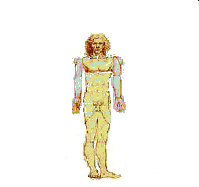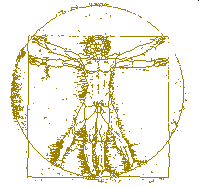Every time a “missing link” is found, that link ceases to be missing. This statement may seem too self-evident to deserve serious mention, but its understanding goes a long way toward explaining some key issues in the development of scientific and theological debates that have arisen in the last century over the so-called missing link in human evolution. Every time a new pre-human fossil is found, someone’s towering theory of why it had been missing falls to the ground. Therefore, in order to understand how some of these theories ever had support, it is necessary to have at least a sketch of the Darwinian theory of human evolution that introduced the original concept of a missing link, and to have a brief history of the paleoanthropological discoveries that have narrowed its meaning.
The founding concepts of Darwinian evolution, as set forward in The Origin of Species, are random variability of inheritable traits, followed by “natural selection,” or a tendency for those organisms with the-most useful traits to out-live and out-number those without. The great importance of Darwin’s contribution to evolutionary theory is that for the first time both the beauty of specialized plants and animals and the ugliness of monstrous mutations could be explained together as inevitable consequences of natural laws. This contribution elevated biology to the level of a pure science, but in the process it also threatened theology by drastically limiting the role of God in the creation of living beings. The situation was precisely as Windsor Hall Roberts described it: “The Darwinian theory at first had seemed to be a death blow to all argument for design in nature.”1 In 1871, Darwin extended his claim with another book, The Descent of Man, which applied evolutionary principles to the origin of human beings. The new claim – that we are the descendents of the great apes – was even more threatening to theology. The idea challenged many of our species’ favorite beliefs about God and the soul, but perhaps most of all, it affronted human vanity. Quaintly indignant to this effrontery in 1860, “the wife of the Bishop of Worcester is said to have exclaimed, ‘My dear, descended from the apes! Let us hope that it is not true, but if it is, let us pray that it will not become generally known!’”2
What’s Missing?
When Darwin wrote The Descent of Man, there were no recognized fossils of intermediate species between ape and man, save seven little-known skulls and a few skeletal remains of what were considered dubious credentials. One Homo sapiens (as distinguished from the modern human species, Homo sapiens sapiens) ‘had been found in Gibralter in 1848, but was largely ignored,” (Leakey, p.32), Another had been uncovered in Neander thal (valley), Germany, in 1856 but the scientific consensus of the time was that the small brain case and protruding brow ridge indicated that it was only the remains of “‘a pathological idiot’” that was “‘of a savage race’” and probably had rickets (Leakey 32). In 1868, remains of five more early humans were found at Cro-magnon, in south-western France, “with the unmistakable high-domed cranium and small jaw of modern humans” (Leakey, p. 32). But this questionable evidence was hardly enough to substantiate Darwin’s claim. Originally, then, the term “missing link” was used to encompass virtually everything between gorilla and modern humans. 1891, with the discovery of Java Man (or Pithecantropus erectus, meaning erect ape-man), “something in between” (Leakey, p. 32) was fixed on the timeline at 750,000 years ago. For a while, “missing link” would refer to any hominid earlier than Java Man.
In 1912, the science of paleoanthropology took a forty-year digression. Apparently motivated by the high stakes of fame traditionally awarded by this prestigious science, an amateur scientist named Charles Dawson did more than merely draw theoretical lines of connection between man and ape. In the historic case of Piltdown Man, Dawson made connections in a much more literal sense: having found a relatively early hominid brain case, he connected it to the jaw-bone of a 500-year-old orangutan, filed down the ape’s pointed molars, stained both pieces dark brown to suggest great age, and presented the forgery to a meeting of the British Royal Society. Every bit as remarkable as Dawson’s audacity was the Royal Society’s gullibility. Ronald Millar explains it this way:
- It seemed that the meeting had been amply forewarned that such a creature as Eoanthropus [Piltdown Man] should figure somewhere in the evolution of man.... Charles Darwin had written of the progenitors of man that “the males had great canine teeth, which served them as formidable weapons.”3
- The Putdown find suggested that early men already had large brains but still had ape-like faces--a concept that satisfies modern human vanity, wish its emphasis on the special qualities of the human intellect.4
- Dart’s fossil was not so agreeable to human vanity. It suggested that just the opposite was true: that face and teeth became recognizably human while the brain was still very small. (Edey, p.15).
In 1948, an upper limit on the age of missing links was set, with the discovery of Preconsul at Lake Victoria by the husband and wife team of Louis and Mary Leakey. About twenty million years old, the exclusively African Preconsul is the most recent common ancestor of modern man and the existing apes, although it is too primitive to count as a hominid itself. The first known hominid – who deserves the title more because he was a tool user than for his weak physical resemblance to humans – is Ramapithecus. Representative Ramapithecines have been found in Africa, India, and Europe, and have been dated as ancient as twelve million and as recent as ten million years old. That leaves two gaps of eight million years each on either side of Ramapithecus – two links which still remain missing.
Today, just how much is missing depends on just how much significance the remaining gaps are interpreted to have. On the one hand, Desmond Collins contends that the last fifteen million years are covered so well that “The concept of a missing link is dead.”5 But on the other hand, Glenn Strickland claims that there are “far too few relics,” and “when we go back more than a couple of million years, the relics are rather doubtful. There are not just a few missing links; whole sections of the chain are missing.”6
Whether or not anthropologists are satisfied with the completeness of the fossil record of human evolution, it is still true that some gaps remain. Both theologians and scientists have proven by the act of their speculations that they feel that these gaps are large enough to throw a theory through.
Theological Controversy
The theological positions that have arisen in response to evolutionism are as numerous and as widely varied in their finest points as the denominations themselves. Nonetheless, in answer to the philosophical argument for atheism (which Darwin propounded and which evolutionism itself at first seemed to embody). Christian theologians had but two options: either off hand denial of the process of evolution, or a gesture of recognition, interpreting both the scripture and Darwinism more liberally to allow a compromise between extremes. In theological terms, this split was between the Creationists (or Fundamentalists), who insisted on a word-for-word reading of Genesis, and the Theists, who were content to “recognize evolution as God’s method of creation.”7 In scientific terms, the same split existed between Catastrophists (who explained the earth’s origin through a series of catastrophies), and Uniformitarians (who believed that the forces that created the world were the same forces we see at work today).
Catastrophism
It is hard to imagine the singlemindedness of the nineteenth century Fundamentalist tradition. It was firmly founded on the story of God’s creation of Man from the dust, as told in what was held to be the divinely inspired book of Genesis. Georges Cuvier (1769-1826), a geologist, naturalist, and member of the French Academy of Science, was the foremost of the scholarly Catastrophists. He was typical of the scores of scientists of his day who studied nature with the express purpose of finding proof of Biblical events. For an indication of how seriously the Catastrophists, Diluvialists, and Fluvialists8 took their divine mission, it may help to emphasize that they were faced with the problem of explaining the entire development of the earth’s structure since its creation at 9:00 am, October 23, 4004 BC.9 It is perhaps a credit to their dedication that many Catastrophists actually believed this could be done, by invoking a series of from twenty-seven to thirty-two floods, the last one being the Noachian Flood of Genesis (Leakey, pp. 21-23).
The Catastrophists were willing to accept the existence of fossils of extinct animals on the ground that whichever animals could not fit in the Ark must have drowned in the flood, and might then have been covered over with sediment. But the authenticity of arrowheads, stone scrapers, and other flint implements found in the same geological strata with the extinct animals was flatly denied. Ronald Millar explains the necessity of this rejection:
- At the Dawn of Mankind, it was believed [through the mid-1800’s at least], Adam and Eve had been born into the physical and moral perfection of the terrestrial Paradise. Therefore, suggestions that man had once lived at the same time as the extinct fauna in a state of primitive destitution, as postulated by the crude flint implements, was preposterous, and anathema to men such as Cuvier. (Millar, p. 21).
These Fundamentalist arguments crumbled with the discovery of Java Man, but one last step was taken before that body of thought gave its last gasp. There was “a more amenable group” which allowed that, “as the Bible had not expressly described the process of forming Adam from the dust, God might possibly ‘have taken the body of some former animal and remodeled it with a human frame and then by an immediate and direct act engrafted onto it the new human spirit’” (Roberts, p. 13). This abrupt remodeling readily accounted for any scarcity of intermediate fossils, but when the germ of compromise had once infected Fundamentalism, it was doomed to lose its predominant position in theology.
A Special Place
If the Fundamentalist tide can be said to have waned; the Theist movement took its place, and waxed eloquent. By lowering their aim from the dry inland reaches of scientific evidence to the more defensible lowlands of theoretical speculation, the theologians no longer needed to call upon a series of floods to cover their argumentative territory. Instead of a torrential contradiction of science, there was a wave of compromise. Oscar Maerth summarizes the new goals of theology quite well:
- The church’s theologians...are trying desperately to fuse the theory of natural evolution from ape to man with religious dogmas in such a way as to leave untouched a divine will, and with it a special place for man.10
Unlike the Fundamentalists, the theists generally accepted fossil evidence as proof that some form of evolution had taken place, but their position was certainly not that of a disinterested search for truth, as Roberts points out:
- The Presbyterian General Assembly of 1882 warned its theological teachers to avoid the dangerous heresy ... and [strict biological] evolutionists were appropriately warned of the punishment awaiting them in the world to come. (Roberts, p. 17).
The theory of “Divine Selection and Survival of the Useful”12 solved this problem by invoking God, not merely in the creation of the first being, but in every evolutionary step from then on, particularly in the step between apes and humans. “For in each variation,” writes Asa Gray, “lies hidden the mystery of a beginning.”13 This new tactic may seem relatively simple, but it had far-reaching impact. The new theory not only necessitated the continual presence of God on earth, but also reopened the possibility that God created Adam and Eve by hand, (though not on the sixth day14) and gave new justification to the explanation that links are missing because God in his all-knowing wisdom skipped some superfluous intermediate steps.
Scientific Theories
The fact that some gaps yet remain in the fossil record has not escaped the notice of scientists any more than of theologians. Some of the scientific theories, if far-fetched, are still quite interesting.
Arboreal Man
Maitland A. Edey presents a peculiar argument in support of his speculations on the sleeping habits of Australopithecines Beginning with only the fossil evidence that Australopithecus cohabited the African savanna with “big cats and hyenas,” he concludes that this progenitor of humanity must have slept in the trees to avoid falling prey to those beasts at night. The assertion seems innocuous enough (perhaps because the accompanying illustration calls up childhood memories of tree-top play forts), but the line of argument used in its support rings a familiarly hollow bell. Edey claims that Australopithecus must have built temporary nests of grass and leaves, because “His closest relatives, chimp and gorilla, both do – and there is no evidence he had the buttock calluses found on many on the monkeys that sleep wedged into the crotches of trees.”15 In other words, the best reason Edey can give for believing that these early hominids were arboreal nest-builders is that he has no evidence that they were arboreal crotch-sitters. He leaves unstated the fact that, furthermore, he has no evidence to indicate that Australopithecines were arboreal in any way at all. But evidence can be expected to be lacking, since dead or dying human ancestors would make tasty meals for those “big cats and hyenas,” when they fell from the trees.
Aquatic Man
Another interesting hypothesis concerning the behavior of early humans suggests that they went through a long period – perhaps ten million years – of close association with the coasts. The Hardy Theory of Aquatic Man, as it is termed, places particular emphasis on several ways in which the modern human anatomy differs from the ape’s, and presumes to explain these differences as adaptations to life in the water. For example, humans are the only primates to have evolved “functionally naked skin.”16 Most mammals make use of their fur as insulation from the cold, but the human anatomy substitutes an adaptive “layer of blubber beneath the skin” that is lacking in other primates. “This subcutaneous fat is typical of aquatic mammals,” including the dolphin, the whale, and the semi aquatic hippopotamus, “but not of land mammals” (Morris, p.297). The advantage of fat versus fur is one of streamlining in the water, according to this theory. The fact that beavers, seals, sea lions, and otters have managed to become remarkably streamlined without losing their fur leaves the theorist undaunted, as these animals live in cold habitats, and need their fur to keep them warm when they emerge on dry land, whereas human ancestors lived in much hotter regions (Morris, p. 296). Numerous other features of the human body are lauded for their potential usefulness to early swimmers, but all are open to alternative explanations. And why is it that human fossils are never found along the coasts? Simply because coastlines have advanced and receded enormously, corresponding to the great Ice Ages and the subduction of continental margins into the earth’s interior. In view of the earth’s tendency to obliterate former coastlines, it seems unlikely that any real bone and stone evidence for an aquatic period in the early history of humanity will ever be found.
Crucial Lack
The various theological and scientific theories that have arisen to explain the ever-shrinking gaps in our species’ fossil genealogy are alike in the severity of the forces they rely on (from Divine Intervention to Plate Tektonics, with ambiguous “potentials,” predation, and downright deceit scattered in between), even if they differ greatly in the objects of their scorn (which objects are most often the other competing theories that try to explain many of the same things). Consequently, they are of greater or lesser repute depending more on whose opinion is sought than on the merits of their argumentation. For however much they differ in their degrees of plausibility, in the range and depth of the explanations they offer, or in their persuasiveness, eloquence or thoroughness of elaboration, all of them have hinged – some of them quite critically – on the absolute lack of evidence to prove or disprove them.
BIBLIOGRAPHY
Appleman, Philip. “Darwin Among the Moralists.” Darwin Ed. Philip Appleman. New York: W.W. Norton and Co., 1979.
Collins, Desmond. The Human Revolution: From Ape to Artist. Oxford: Phaidon Press, 1976.
Dole, George Henry. Divine Selection or The Survival of the Useful. New York: New-Church Board of Publication, 1903.
Edey, Maitland A. The Missing Link New York: Time-Life Books, 1972.
Hudson, Tomson Jay. The Divine Pedigree of Man or The Testimony of Evolution and Psychology to the Fatherhood of God Chicago: A. C. McClurg and Co., 1900.
Leakey, Richard E. and Roger Lewin. Origins New York: E. P. Dutton, 1977.
Lewis, Tayler. The Six Days of Creation; or The Scriptural Cosmology with the Ancient Idea of Time-Worlds in Distinction from Worlds in Space Schenectady: G. Y. Debogert, 1855.
Maerth, Oscar Kiss. The Beginning Was the End Trans. Judith Hayward. London: Michael Joseph Ltd., 1973.
Millar, Ronald. The Piltdown Men. London: Victor Gollancz Ltd., 1972.
Morris, Desmond. Manwatching: A Field Guide to Human Behavior New York: Harry N. Abrams, Inc., 1977.
Roberts, Windsor Hall. The Reaction of American Protestant Churches to the Darwinian Philosophy 1860-1900 Chicago: U, of Chicago Press, 1938
Strickland, Glenn G. Genesis Revisited: A Revolutionary New Solution to the Mystery of Man’s Origins New York: Dial Press, 1979.
ENDNOTES
1 Hall Roberts, The Reaction of American Protestant Churches to the Darwinian Philosophy 1860-1890 (Chicago: U. of Chicago, 1938), p. 18.
2 E. Leakey and Roger Lewin, Origins (New York: E. P. Dutton, 1977), p. 21.
3 Millar, The Piltdown Men (London: Gollancz, 1972), pp.131-132.
4A. Edey, The Missing Link (New York: Time-Life Books, 1972), pp. 15-16.
5 Collins, The Human Revolution: From Ape to Artist (Oxford, Phidon Press, 1976), p. 68.
6 G. Strickland, Genesis Revisited: A Revolutionary New Solution to the Mystery of Man Origins (New York: Dial Press, 1979), p. 15.
7 Jay Hudson, The Divine Pedigree of Man or the Testimony of Evolution and Psychology to the Fatherhood of God (Chicago: A. C. McClurg & Co., 1900), p. viii.
8 Catastrophists believed that the geological features of the earth could be explained by tremendous catastrophies, usually thought to be initiated by God. Diluvialists stressed sedimentation during the floods, whereas Fluvialists stressed erosion by fast running rivers when the flood waters returned to the sea.
9 Leakey p. 21. This was the year, allegedly calculated from a rigid application of numerology to Bible study, that James Ussher, Archbishop of Armagh, came up with in 1650. It was endorsed by Dr. John Lightfoot, Master of St. Catherine’s College, Cambridge, England, who supplied the calendar day and time.
10 Kiss Maerth, The Beginning Was the End trans. from the German by Judith Hayward (London: Michael Joseph, Ltd., 1973), pp. 19-20.
11 Joseph Le Conte, “Evolution in Relation to Materialism,’ Princeton Review VII (March 1881), pp. 161-162, as cited in Roberts, p. 14.
12 George Henry Dole, Divine Selection or The Survival of the Useful (New York: New-Church Board of Pub., 1903), p. 42.
13 Asa Gray, as cited in Dole, p. 39.
14 The age of the earth was the focus of a separate and earlier theological debate with science, but it is not directly related to the missing link. However, Tayler Lewis gave a theologicai resolution to the dilemma of the six-day creation with the argument that what is a day for God might well be several hundred million years to men. See Tayler Lewis, The Six Days of Creation; or: The Scriptural Cosmology etc. (Schenectady: G. Y, Debogert, 1855), particularly Chapter XX, “Work of the Sixth Day”, pp. 246-260.
15 Edey, p. 30. In the interest of fairness to the author, Edey’s book, The Missing Link presents much compelling evidence for the common heritage of man and ape, even if the arboreal theory is weakly supported. Edey’s theory of an arboreal Australopithecus is a variation on a more accepted hypothesis that some ancestor of Preconsul was an arboreal brachiator, swinging from limb to limb in the trees. This is deduced from the position of the shoulders, which is not adequately developed for effective brachiation in any of the hominids. Leakey presents a readable discussion of arm-swinging apparati. See Leakey, pp. 38-39.
16 Morris, Manwatching: A Field Guide to Human Behavior (New York: Harry N. Abrams, Inc 1977), p. 296.
Essay
Title
THE ROLE OF THE MISSING LINK
IN THEOLOGICAL AND SCIENTIFIC DEBATES
Synopsis
A study of the shrinking concept of a “missing link” in human evolution
Topic
Freshman Composition
ShortTitle
The Missing Link
Date
April 29, 1983
Professor
Prof. Diana Henderson
Excellently written. |
Illustration2
Illustatration1
GraderQuote
Copyright © W. Murray Sexton. All rights reserved.








TM



